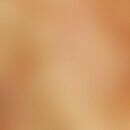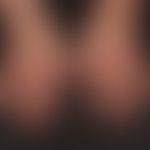Synonym(s)
HistoryThis section has been translated automatically.
DefinitionThis section has been translated automatically.
Rare, acquired, systemic, antibody- or immune complex-mediated group of autoimmune diseases with immunological reactions against vascular and muscle fiber proteins and diagnostically groundbreaking inflammatory skin manifestations. Furthermore, there are inflammatory atrophying vascular connective tissue reactions as well as segmental necroses of the striated musculature, which manifest themselves in a clinically usually clearly prominent muscle weakness.
Dermatomyositis, like other autoimmune myositides with other "collagenoses", can also occur as overlap syn dromes and, in association with malignant tumors, as a paraneoplastic syndrome(dermatomyositis, malignoma-associated).
You might also be interested in
ClassificationThis section has been translated automatically.
Clinically, a distinction is made (with frequencies):
- Adult polymyositis (PM- without skin symptoms) 30% - is not seen dermatologically.
- Adult typical dermatomyositis (DM - idiopathic dermatomyositis)/25%.
- Dermatomyositis associated withmalignancy (CAM) /10%.
- Dermatomyositis associated withcollagenoses (CTM - as part of an overlap syndrome/overlap group)/30%
- Amyopathic dermatomyositis (ADM) (in adults and children)
- Juvenile dermatomyositis (with vasculitis)/5%.
Occurrence/EpidemiologyThis section has been translated automatically.
Incidence (juvenile dermatomyositis): 0.2/100,000 inhabitants/year.
Incidence (adult dermatomyositis): 0.6-1.0/100,000 inhabitants/year.
African-Americans are more frequently affected than Caucasians.
EtiopathogenesisThis section has been translated automatically.
Together with polymyositis and inclusion body myositis, dermatomyositis belongs to the group of inflammatory myopathies. Environmental factors, especially sun exposure, can lead to an exacerbation of dermatomyositis.
- Genetic predispositions
- exist for all idiopathic myositis with the haplotypes HLA-B8, HLA DRB 03; HLA-A68 and HLA-DR3 for classic and juvenile dermatomyositis. In drug-associated dermatomyositis, the haplotypes HLA-B 08 and HLA-DR4 were detected. No HLA associations are known for amyopathic dermatomyositis.
- Infections:
- Antibody formation against muscle antigens (AK against the nuclear Mi-2 antigen, antisynthetase AK) is etiologically significant. Viral infections ( picornaviruses or coxsackieviruses) are discussed as a trigger mechanism. Antibodies against viral surface antigens can have structural similarities with nuclear antigens and induce antibody formation. In children, bacterial focal events can also cause antibody formation.
Several case reports indicate a link between COVID-19 vaccination and dermatomyositis (Ooi XT et al. 2022; Sugimoto T et al. 2023).
- A humoral immune mechanism has been described:
- This involves the deposition of C5b-9 complement complexes on the endothelium of the skin and skeletal muscles. For both polymyositis and dermatomyositis, there is an increased frequency of haplotypes with DR3 (up to 75%). Dermatomyositis symptoms have been observed in congenital immunodeficiencies ("X-linked immunodeficiency"/C9 defects), as well as in AIDS and HTLV-1 associated T-cell lymphomas (see lymphoma, cutaneous T-cell lymphoma below).
- Drugs:
- Drug induction is rarer, e.g. by D-penicillamine, procainamide, NSAIDs, simvastatin, antimalarials; interferon alpha, allopurinol, immune checkpoint inhibitors
- Dermatomyositis as cutaneous paraneoplasia:
- in 18-32% of patients; mostly patients > 50 years): Accumulation in individual families. The relative risk of malignancy development is 2.4 to 3.8 times higher than in the average population. The risk of tumor development is highest in the first year of diagnosis and decreases continuously in the following years. The most common tumors are ovarian carcinomas, gastrointestinal carcinomas, lung and breast carcinomas, prostate carcinomas and non-Hodgkin's lymphomas. In Asians, nasopharyngeal carcinomas are particularly common.
- The tumor association is absent in juvenile dermatomyositis. In tumor-associated DM, the clinical symptoms may be due to a cross-reactive immune response directed against tumor-associated antigens on cancer cells as well as against constitutive antigens in skin and muscle cells. It is postulated that the TIF-gamma antibody correlates positively with disease activity.
ManifestationThis section has been translated automatically.
In the adult form there is gynecotropy: women are affected about 1.5-2 times more frequently than men. In adult dermatomyositis there are 2 peaks in frequency, at 35-44 years of age and 55-60 years of age.
No gender preference in childhood (this statement is not found in other studies, here: F:M=6:1). First manifestation of juvenile dermatomyositis: Mostly 7th-8th year of life.
ClinicThis section has been translated automatically.
General: General fatigue with muscle weakness and muscle soreness. Patients can perform their normal activities (e.g., climbing stairs, combing hair) with difficulty or not at all.
Note: Patient appears tired at consultation, leans on chair when standing up, hand clasp is feeble, gait sluggish, voice quiet to broken.
Integument (often initial sign of dermatomyositis: skin manifestations precede muscle weakness in 1/3 of cases).
Initial stage: Initially, areal facial swellings with conspicuous eyelid edema, heliotrope, red to blue-violet, areactive but also pruritic or painful erythema and/or plaques that appear butterfly-shaped over the cheeks, expose a perioral zone, and heliotrope the neckline. Less common are blurred, patchy satin-red erythema on the back. Specifically, the following phenomena are described:
- Gottron's sign: Diagnostically significant are satin-red, streaky erythema and papules on the extensor sides of the fingers (= Gottron's sign in about 70% of patients).
- Nail fold hyperkeratosis: (the attempt to push back the nail fold is very painful = Keining sign) with mega and tufted capillaries, elongated and torqued capillaries possibly with hemorrhages (capillary microscopy).
- Heliotropic erythema:wine-red diffuse erythema is visibleespeciallyin the sun-exposed areas of the skin (face, eyelids, décolleté).
- Perioral pallor: characteristic is the absence of erythema in the perioral region (thus the perioral region appears pale: perioral pallor).
- V sign: confluent macular erythema spreading in a V shape over the lower anterior neck and upper chest region (appearances are often associated with anti-Mi-2 autoantibody).
- Shawl sign: confluent areal erythema localized like a scarf tied around it.
- Holster sign: red or red-purple, planar erythema localized to the lateral thighs or hips in the shape of a worn gun holster.
Late stage: Variegated (poikilodermic) skin appearance due to brown-red discoloration of the lesions with sunken atrophic areas, sometimes also coarse sclerotic plaques with calcification processes (especially in children and adolescents). Often the skin changes are combined with diffuse effluvium .
- Mechanic hands: hyperkeratotic cracked skin on the palmar and lateral aspect of the fingers.
Muscles: Increasing, symmetrical, painful (muscle soreness) muscle weakness, especially of proximal limb segments. Calcifications of the muscles are possible, rather rare in adults, up to 40% in children and adolescents (see below Dermatomyositis, juvenile).
Skeletal system: Arthralgias and arthritides occur in about 25% of patients with inflammatory muscle diseases. Partly type of symmetrical polyarthritis, also as oligo- or monarthritis. Rarely mutilating arthritis (DD: antisynthetase syndrome; see overlap syndrome below). Further: Severe osteoporosis, more extensive calcification of soft tissues (tendons, muscles, aponeuroses), and significant joint deformities (joint space is preserved!).
Lung: Lung involvement (primary interstitial pneumonitis) in 15-30% of patients.
Vessels: Concomitant Raynaud's phenomenon or scleroderma-like edema (hands) suggest overlap syndrome. This symptomatology is rarely associated with malignant tumor.
Adipose tissue: Rare but clinically established manifestation of dermatomyositis with indurated, painful nodules or plaques on the abdomen, buttocks, and arms. Ulceration and lipodystrophy may occur.
Mucous membranes: ulcers of the oral mucosa in 10% to 20%.
Internal organs: involvement of heart, intestine and kidneys. Dysphagia due to weakness of oropharyngeal muscles. Associated: bronchopneumonia (aspiration due to dysphagia), hepato-splenomegaly, nephritis, tenderness of large nerve trunks, mental changes, focal retinitis peripapillosa, cotton-wool exudate, small streaky hemorrhages in the nerve fiber layer, papilledema, rarely episcleritis and scleritis.
LaboratoryThis section has been translated automatically.
Serum: CK i.S. (especially MM type) up to 50-fold elevated, aldolase, GOT, GPT, LDH elevated. Creatinine excretion increased in 24h urine during relapse.
Antibodies are becoming increasingly important. A distinction is made between myositis-associated antibodies (MAA) and myositis-specific antibodies (MSA). Antinuclear antibodies (ANA) can be detected in about 33% of cases. Antibodies against MI-2 are an important indicator of dermatomyositis. The following antibody profile is also possible:
| Autoantibodies | Frequency (%) | Clinical association |
|---|---|---|
| Mi-2 |
20-30% 5% |
Classical DM Paraneoplastic DM |
| MDA5 (CADM140) | 50% | Amyopathic DM |
| SAE | 5-8% | Adult DM |
| TIF-1 (p155/140) |
40-75% 20-25% 30% |
Paraneoplastic DM, high incidence with malignancies (lung, stomach, breast, etc.) Adult DM Juvenile DM |
| NXP-2 | 25% | Juvenile dermatomyositis |
| t-RNA synthetases (e.g. Jo-1) | 5-20% | Antisynthetase syndrome |
| SRP | 5% | Adult dermatomyositis |
| MDA5 | highly significantly indicated pulmonary fibrosis or upcoming pulmonary fibrosis. |
| Autoantibodies | Frequency% | Clinical association |
| Ro (SSA) | 19% | Antisynthetase syndrome (anti-Jo-1 syndrome |
| U1-RNP | 8% | Mixed connective tissue syndrome |
| PM/Scl (75-100kd) | 2% | Sclerodermatomyositis |
| Ku | 1% | Overlap myositis (overlap myositis) |
- Blood count: lymphopenia, often marked eosinophilia, leukocytosis with left shift also occurs.
- ESR: moderate to moderate acceleration.
- Serum electrophoresis: increase in alpha 2- and gamma-globulin.
- Urine: creatinine and creatininuria. Proteinuria in relapse, myoglobinuria.
HistologyThis section has been translated automatically.
Integument: Uncharacteristic interface dermatitis of varying severity, possibly with mild acanthosis or even atrophy with degeneration of basal keratinocytes.
Electron microscopy: Tubulovesicular inclusions in the vascular endothelium.
Muscle: Segmental muscle fiber necrosis, loss of transverse striation, eosinophilic granular necrosis, interstitial mononuclear infiltrate, possible vascular senescence with intimal hypertrophy and fibrin deposition in the small arterioles. Relative decrease in CD4 T cells and lymphocytes.
Adipose tissue: Mixed septal/lobular panniculitis with doming infiltrate of lymphocytes, plasma cells, and focal membranocystic adipose tissue necrosis. Lymphocytic vasculitis may occur.
DiagnosisThis section has been translated automatically.
Clinic
Histology and immunohistology from skin biopsies and muscle biopsies
Electromyogram: short polyphasic potentials, fibrillations
Creatine excretion in 24-hour urine
ANA low-titer positive in majority of patients
Myositis-associated AK are (in contrast to polymyositis) rather rare in dermatomyositis (Jo-1-AK, Mi-2-AK). In patients with AK against aminoacyl-t-RNA synthetases, SRP or Mi-2, myositis is the primary cause of the disease. The Jo-1-AK is of greatest clinical importance (see antisynthetase syndrome below).
To diagnose "polymyositis", at least 3 of the following criteria should be positive:
- Muscle enzymes (creatinine kinase)
- EMG
- muscle biopsy.
In many cases, the tentative diagnosis must be made on the basis of clinical symptoms alone, since other parameters appear inconsistently.
Differential diagnosisThis section has been translated automatically.
Systemic lupus erythematosus (usually acute onset, absence of Gottron's sign; classic serology).
Acute contact allergic eczema of the face (extensive "contact-related" eczema, possibly weeping (dermatoymositis never weeping), severe itching, no general complaints!)
Mixed connective tissue disease (serological clarification)
Rosacea erythematosa (skin changes are quite similar at first sight. Accompanying follicular papules or pustules exclude DM. Mostly nutritive or emotionally triggered flushing phenomena. Never general complaints!)
Dermatomyositis-like skin signs in infection by B. burgdorferi, in T-cell lymphoma, atopic eczema (serological and histological clarification of the underlying disease).
Trichinosis and cysticercosis (myalgias, fatigue, urticarial, often esosinophilic exanthema; marked blood eosinophilia. Eosinophilia would be unusual in dermatomyositis).
Myositides of other etiologies (e.g., in the setting of a hypereosinophilia syndrome, no dermatologic component)
Thyrotoxic myopathy and muscular dystrophies (neurologic workup; lacks the seminal dermatologic phenomena of dermatomyositis).
General therapyThis section has been translated automatically.
Tumor exclusion (esp. ovary, lung, pancreas, colon, non-Hodgkin lymphoma) at least 1 time/year.
Exclusion of bacterial foci, remediation if necessary.
In acute phases of disease, bed rest and general roborative measures.
Due to long-term glucocorticoid treatment, recommendations such as low-salt diet and fluid restriction and, if necessary, substitution of calcium and vit. D (vigantolettes 1000 1tbl./day) should be carried out in case of incipient osteoporosis.
Accompanying physiotherapeutic exercises or physical measures to improve muscle function are recommended.
Photoprotective measures are necessary in all variants of dermatomyositis.
External therapyThis section has been translated automatically.
Internal therapyThis section has been translated automatically.
Glucocorticoids such as prednisolone (e.g. Decortin H) in a dosage of (at least) 1.0-2.0 mg/kg bw/day. In highly acute courses, steroid pulse therapy can initially be administered at a dosage of 1 g/day for 3-5 days. Continuation depending on clinical symptoms with prednisolone at a dosage of 1.0-2.0 mg/kg bw/day. Fluorinated glucocorticoids (e.g., dexamethasone, triamcinolone) should be avoided because of their potential to cause myopathy.
Early combination therapy with azathioprine (Imurek) 1.0-3.0 mg/kg bw/day is recommended to save glucocorticoids. Slow dose reduction of glucocorticoids (e.g., by 5-10 mg/day every 2-4 weeks) depending on clinical findings until a maintenance dose (10-15 mg/day) is reached, which usually must be maintained for months to years. The dose may need to be increased again if clinical findings worsen. Progress controls and activity determinations are performed by determination of muscle enzymes (creatine kinase, aldolase, lactate dehydrogenase) in addition to clinical findings. An attempt at cessation can only be attempted after several months of freedom from symptoms (normalization of serum creatine kinase levels). Prior determination of thiopurine methyltransferase (TPMT) may be performed to assess genetic mismetabolism. Contraindications: Combination with allopuriol!
Methotrexate (MTX) is an alternative to azathioprine. Start with 7.5-10.0 mg/week p.o. or i.v., increasing in weekly increments of 2.5 mg up to a maintenance dose of 25 mg/week Cave! No i.m. injections, because of increase of muscle enzymes no follow-up is possible!
Alternative: Cyclophosphamide (e.g. Endoxan) 100-150 mg/day; described also as shock therapy in a dosage of 0.5-1.0 g/m2 KO/month i.v.
Alternatively (case reports only): Ciclosporin A (Sandimmune) 3.0-5.0 mg/kg bw/day divided into two doses.
Alternative (case reports only): Mycophenolate mofetil (CellCept) 2.0 g/day p.o. Similar effect to azathioprine (antipurine metabolite) with a start-up time of about 3 months.
Alternative: high-dose immunoglobulins (IVIG) in doses of 0.5-1.0 g/kg bw/day i.v. for 3 days (repeated every 4 weeks) especially in refractory active dermatomyositis patients. Intravenous immunoglobulin therapy ( IVIG therapy) has also proven effective in juvenile forms of dermatomyositis. Caution. Very high therapy costs!
Alternatively, in case of insufficient response to glucocorticoids and IVIG, initiation of therapy with Rituximab (Mabthera) 100-375 mg/m2 KO i.v. 4 times weekly. Clear evidence for the success of this therapy is missing so far.
Alternative: In severe, therapy-resistant cases, plasmapheresis remains as ultima ratio; confirmed results are still pending.
In current clinical trials: Eculizumab (anti-complement C5), Tocilizumab (anti-interleukin-6), Anakinra (anti-IL-1 receptor, see also interleukin-1), Gevokizumab (anti-interleukin-1beta), anti-interleukin-17 (see interleukin-17).
Progression/forecastThis section has been translated automatically.
Unpredictable development of the course. The duration of the disease varies (months to decades). In smaller cohorts, the 5-year survival rate was 95% and the 10-year survival rate was 84%. 50-75% of patients treated with immunosuppressants show significant improvement in clinical outcome. Older age and association with malignancy are associated with poor prognosis.
Note(s)This section has been translated automatically.
LiteratureThis section has been translated automatically.
- Aggarwal R et al. (2022) ProDERM Trial Group. Trial of Intravenous Immune Globulin in Dermatomyositis. N Engl J Med 387:1264-1278.
- Bernard P, Bonnetblanc JM (1993) Dermatomyositis and malignancy. J Invest Dermatol 100:128-132
- Bruce H et al (2009) Cutaneous manifestations of internal malignancy. Cancer J Clin 59:73-98
- Callen JP, Wortmann RL (2006) Dermatomyositis. Clin Dermatol 24: 363-373
- Cherin P et al. (1991) Efficacy of intravenous gammaglobulin therapy in chronic refractory polymyositis and dermatomyositis: an open study with 20 adult patients. Am J Med 91: 162-168
- Dalakas MC (2003) Therapeutic approaches in patients with inflammatory myopathies. Semin Neurol 23: 199-206
- Dalakas MC (2003) Polymyositis and dermatomyositis. Lancet 57: 971-982
- Gardner-Medwin JM et al. (2002) Incidence of Henoch-Schonlein purpura, Kawasaki disease, and rare vasculitides in children of different ethnic origins. Lancet 360: 1197-1202
- Gürcan HM et al. (2009) A review of the current use of rituximab in autoimmune diseases. Int Immunopharmacol 9: 10-25
- Levine TD (2005) Rituximab in the treatment of dermatomyositis: an open-label pilot study. Arthritis Rheum 52: 601-607
- Mendez EP (2003) US incidence of juvenile dermatomyositis, 1995-1998: results from the National Institute of Arthritis and Musculoskeletal and Skin Diseases Registry. Arthritis Rheum 49: 300-305
- Moghadam-Kia S et al. (2017) Modern Therapies for Idiopathic Inflammatory Myopathies (IIMs): Role of Biologics. Clin Rev Allergy Immunol 52:81-87.
- Mori H et al. (2005) Relapse of dermatomyositis after 10 years in remission following curative surgical treatment of lung cancer. J Dermatol 32: 290-294
- Ooi XT et al. (2022) Manifestation of a cancer-associated TIF-1 gamma dermatomyositis after COVID-19 vaccine. Int J Dermatol 61:1425-1426
- Sato S et al. (2005) Autoantibodies to a 140-kd polypeptide, CADM-140, in Japanese patients with clinically amyopathic dermatomyositis. Arthritis Rheum 52: 1571-1576
- Sugimoto T et al. (2023) Appearance of anti-MDA5 antibody-positive dermatomyositis after COVID-19 vaccination. Mod Rheumatol Case Rep 7:108-112.
- Sunderkötter C et al. (2016) Guideline dermatomyositis - excerpt from the interdisciplinary S2k guideline on
- myositis syndromes of the German Society of Neurology. JDDG 14: 321-333
- Tersiguel AC et al. (2014) Prevalence of cancer in the Afro-Caribbean population presenting dermatomyositis and anti-synthetase syndrome: a preliminary study conducted at Pointe-à-Pitre University Hospital, 2000-2012. Ann Dermatol Venereol141:575-580
- Unverricht H (1887) On a peculiar form of acute muscular inflammation with a clinical picture resembling trichinosis. Münch med Wschr 34: 488-492
- Wagner EL (1863) Case of a rare muscular disease. Arch Heilk 4: 282-283
Incoming links (94)
Acquired haemophilia A;; Adult dermatomyositis; Agammaglobulinemia 3, mutation in CD79A; Ama; Antisynthetase syndrome; Autoimmune diseases; Capillary microscopy; Ccl13; Ccp-ak; CD19 CAR-T cells; ... Show allOutgoing links (57)
Acanthosis; Adult dermatomyositis; Aids; Allopurinol; Anakinra; Antimalarials; Antinuclear antibodies; Antisynthetase syndrome; Atopic dermatitis (overview); Azathioprine; ... Show allDisclaimer
Please ask your physician for a reliable diagnosis. This website is only meant as a reference.
































